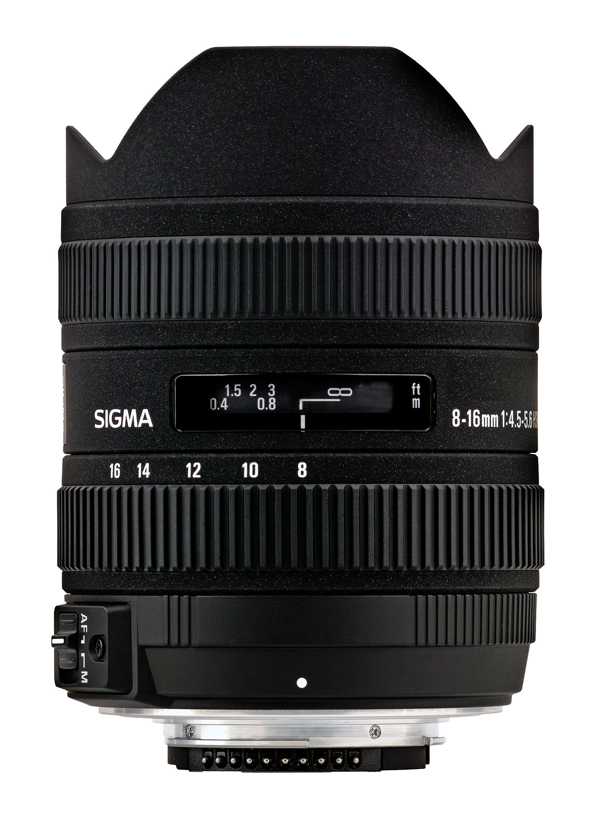Sigma 8-16mm f/4.5-5.6 DC HSM
 |
| Gary Wolstenholme takes a look at this unique lens, which is currently the widest rectilinear lens available for APS-C sensor cameras. |
This 8-16mm lens from Sigma costs around £590 and apart from being the widest lens currently available for APS-C cropped sensor cameras, it also sports silent internal focusing but doesn't accept filters, which may put those who like to use filters off this lens.
As there is nothing else quite as wide as this currently, the closest alternatives are the various ultra wide zooms that start at 10mm. This extra 2mm does make a noticeable difference, and should make this lens every estate agent's best friend, as it will allow them to make their shoebox sized bedsits look positively palatial. Sigma offer two different 10-20mm lenses, which both offer silent internal focusing and accept screw in filters. The more expensive of the two has a constant aperture of f/3.5 through the zoom range and costs around £480. The cheaper alternative has a slower, variable aperture of f/4-5.6 and costs around £400.
Tamron's closest match is their 10-24mm f/3.5-4.5 SP lens, (reviewed here http://www.ephotozine.com/article/tamron-af10-24mm-f-3-5-4-5-di-ii-ld-asph-macro-12931 )which isn't as wide as the lens being reviewed here and doesn't have silent focusing, but only costs around £380.
Canon users have the EF-S 10-22mm f/3.5-4.5 to choose from, which costs around £640 and includes a silent focusing motor.
The closest match in Nikon flavour is their 10-24mm f/3.5-5.6 which also sports silent focusing, and costs around £635.
Sony's current widest lens for their crop sensor Alpha camera is their 11-18mm DT AF lens, which lacks silent focusing and the width of the Sigma, as all these lenses do, and it costs around £530.
Pentax don't currently make a rectilinear lens wider than 12mm, but they do make a 10-17mm fisheye zoom, which costs around £430 and lacks a silent focusing motor and will make your straight lines all bendy, which is fine if that's what you're after.
Sigma 8-16mm f/4.5-5.6 DC HSM: Handling and features
For a lens with such a wide field of view, this 8-16mm optic is surprisingly compact and lightweight and Sigma have achieved this without compromising the overall build quality. Much of the lens barrel is constructed from high quality plastics with a powder coated effect applied, which looks very smart, but can show marks easily. Both the zoom and focus rings are flush to the lens barrel, with ridged rubber grips, which help to give the lens a very positive feel.
As this is a HSM lens, manual focus adjustments can be made at any time, which can be handy if you wish to fine tune the focusing while using autofocus. To be honest though, on a lens as wide as this I rarely found use for this feature as the depth of field is so great at 8mm, it can be difficult to make adjustments manually.
A scalloped lens hood is built into the lens barrel, providing as much shade as is possible to the large bulbous front element. As is the case with other similarly wide lenses, such as Sigma's 12-24mm and 15-30mm lenses, there is no way to attach a filter to the front of the lens without causing vignetting. This may pose issues for those who enjoy using neutral density graduated filters for landscapes. Focusing is performed internally and the lens does not extend during zooming either.
As you might expect from an ultra-wide lens, focusing is lightning quick, and silent thanks to the HSM motor. No hyperfocal markings are provided on the lens' distance scale, which is a shame, as hyperfocal focusing can be extremely useful with a lens like this.
Overall, I really enjoyed using this 8-16mm optic, thanks to its compact dimensions, excellent build quality and extremely wide field of view.
Sigma 8-16mm f/4.5-5.6 DC HSM: Performance
Throughout the range, this 8-16mm optic delivers very good sharpness in the centre from maximum aperture, with the quality towards the edges catching up as the lens is stopped down.
At 8mm the sharpness in the centre of the image is already outstanding at f/4.5, although the level of sharpness drops noticeably as you move towards the edge of the frame. Peak quality across the frame is achieved between f/8 and f/11, where the sharpness in the centre is very good, and the resolution recorded towards the edges has increased to good levels.
The lens behaves in much the same way throughout the zoom range, producing images with superb sharpness in the centre, although at longer focal lengths, the increase in sharpness towards the edges of the frame as the lens is stopped down is less pronounced.
Sigma have pushed the boundaries of what is possible by creating a lens for APS-C DSLRs with such a wide field of view, and unfortunately this shows in the level of colour fringe towards the edge of the frame. Chromatic aberrations are at their highest level at 8mm and f/4.5 where the fringing covers and area of 1.76 pixel widths. This will be quite visible in images with high contrast objects towards the edge of the frame, such as tree branches, or some architecture. Luckily many image editing software packages offer effective tools to correct this phenomenon, so it may be worth familiarising yourself with these in cases when the fringing is too disturbing.
Falloff of illumination towards the corners of the frame is quite pronounced, especially at 8mm, where the corners are 4.37 stops darker than the image centre at f/4.5. This will be particularly noticeable on areas of flat tone, such as overcast skies. Image are not visually uniform until f/11, with even f/8 showing a noticeable level of darkening towards the corners. The lens behaves itself much better with regards to light falloff at the telephoto end of the zoom range. At f/5.6 the corners are only 0.895 stops darker than the image centre and images are visually uniform by f/8.
For a lens covering such an extreme field of view, distortion levels are surprisingly low. At 8mm Imatest recorded 5.62% barrel distortion, which will certainly be noticeable, but this level is lower than many lenses that aren't as wide, which is quite impressive. At 16mm, the level of barrel distortion drops to 0.562%, which is a very low level indeed and should pose few problems, even with straight lines close to the edge of the frame. Thankfully the distortion pattern is uniform throughout the zoom range, which means any distortion should be fairly simple to correct in image editing software afterwards, if absolutely straight lines are critical.
Even with the built-in scalloped hood, it was always going to be inevitable that this lens would be quite prone to flare. Considering the nature of the bulbous front element, the lens doesn't perform too badly when compared to lenses of a similar design, but strong light sources may cause blue ghosts and a severe loss of contrast depending on how it catches the front element. So long as care is taken when composing in harsh lighting conditions the lens is still perfectly usable.
Sigma 8-16mm f/4.5-5.6 DC HSM: Verdict
Having such a wide field of view, coupled with the close minimum focus distance of only 24cm, makes this lens a lot of fun to use. It may not be everyone's cup of tea, especially if you like to use filters on your wide lenses, and a lens as wide as this can be quite a challenge to use well. Saying that, if you find yourself hitting the stop at the wide end of the zoom on your current APS-C compatible ultra-wide zoom, then this lens is certainly worth a look.
Overall it is well built, well priced and performs pretty well. Just like its full-frame 12-24mm cousin, this lens is one of a kind and should find a home in plenty of photographer's kit bags.
 |
| A truly unique lens, offering a wider field of view on APS-C DSLRs then anything else currently available. |
 Outstanding sharpness in the centre
Outstanding sharpness in the centre Excellent build
Excellent build Unique wide angle field of view for APS-C cameras
Unique wide angle field of view for APS-C cameras Compact dimensions
Compact dimensions Silent focusing
Silent focusing Low distortion
Low distortionSigma 8-16mm f/4.5-5.6 DC HSM: Cons
 CA towards edges of the frame at 8mm
CA towards edges of the frame at 8mm Falloff at 8mm
Falloff at 8mm No way to attach filters
No way to attach filters| FEATURES |  |
| HANDLING |  |
| PERFORMANCE |  |
| VALUE FOR MONEY |  |
| OVERALL |  |
Sigma 8-16mm f/4.5-5.6 DC HSM: Lens specification
| Price | £590.00 |
| Contact | http://www.sigma-imaging-uk.com |
| Filter size | 72mm on push on hood |
| Format | APS-C |
| Construction | 15 elements in 11 groups |
| Angle-of-view | 114.5 - 75.7 degrees |
| 35mm equivalent focal length (on APS-C body) | 12-24mm |
| Internal focusing | Yes |
| Image stabilisation | No |
| Minimum focus | 24cm |
| Maximum aperture | f/4.5-5.6 |
| Minimum aperture | f/22-29 |
| Weight | 555g |
| Size | 75x 105.7mm |
| In the box | Fitted Padded Case Front and Rear Caps Instruction Manual 1 Year Warranty Card |
The Sigma 8-16mm f/4.5-5.6 DC HSM costs around £549 and is available from Warehouse Express here:
Sigma 8-16mm f/4.5-5.6 DC HSM for Canon
Sigma 8-16mm f/4.5-5.6 DC HSM for Nikon
Sigma 8-16mm f/4.5-5.6 DC HSM for Sony
Sigma 8-16mm f/4.5-5.6 DC HSM for Pentax
Sigma 8-16mm f/4.5-5.6 DC HSM for Sigma
thank you for the review of this interesting lens.
Always a fan of ultrawides and fisheyes, i keep sometimes
wondering -given the increased distortion of every ultrawide in the wides- if there is little to choose between an ultrawide in the first place or a fisheye with the software-based correction (needs some different technique and discipline, though).
In our case, what is the fov of this sigma 8-16 compared to, say, the pentax/tokina 10-17 fisheye?
just some thoughts.....
Always a fan of ultrawides and fisheyes, i keep sometimes
wondering -given the increased distortion of every ultrawide in the wides- if there is little to choose between an ultrawide in the first place or a fisheye with the software-based correction (needs some different technique and discipline, though).
In our case, what is the fov of this sigma 8-16 compared to, say, the pentax/tokina 10-17 fisheye?
just some thoughts.....
Add your message
Login required
Please login here or if you've not registered, you can register here. Registering is safe, quick and free.
Please login here or if you've not registered, you can register here. Registering is safe, quick and free.
photodo Stats
1102 lenses
428 MTF tests
74 in-depth photodo reviews
100+ users join each day
Help the lens community by reviewing or rating a lens today via our lens search
428 MTF tests
74 in-depth photodo reviews
100+ users join each day
Help the lens community by reviewing or rating a lens today via our lens search
Latest Lens Reviews
- Chinon 28mm f/2.8 Vintage Lens Review
- Canon EF 70-200mm f/4L IS II USM Lens Review
- Samyang AF 85mm f/1.4 EF Review
- Sigma 70mm f/2.8 DG Macro Art Review
- Samyang AF 24mm f/2.8 FE Review
- Meike 50mm f/1.7 Review
- Tamron 70-210mm f/4 Di VC USD Review
- Lensbaby Burnside 35mm f/2.8 Review
- Asahi Super Takumar 50mm f/1.4 Review
- Asahi Super-Multi-Coated Takumar 135mm f/3.5 Review








